Ah, Lake O’Hara…perhaps the most frustrating photographic experience of my life…
Some background information is necessary. Back in May, when I was finalizing the timing for this trip to the Canadian Rockies, I scheduled the first eight days at Lake Louise and Jasper; the final 5-6 days were to be spent on a photo tour centered in David Thompson Country, led by Royce Howland (much more on the tour later in this series). While I was in the process of trying to prioritize daily shooting options while staying in Lake Louise–I knew I had far more that I wanted to do than time in which to do it–I asked Royce if he had any suggestions. He threw me a curve ball by recommending something that hadn’t been on the menu–a day trip to Lake O’Hara.
I hadn’t been familiar with Lake O’Hara–which is located just across the provincial border from Lake Louise, in Yoho National Park in British Columbia–up to that point, but Royce described it as “one of the crown jewels of the Canadian Rockies.” When a photographer with decades of experience in the region (Royce) makes a statement like this, someone who doesn’t know his a** from his elbow with regard to the area (me) should sit up and take notice…so I did.
Royce warned me that access to the Lake O’Hara area was highly limited and that securing permission to enter was–I’ll be generous–a bit convoluted. Lake O’Hara lies at the end of a road, roughly seven miles in length, that is closed to private vehicles. There is no formal limit to the number of people who can hike into the area–the length of the hike (it’s all uphill–imagine doing that with a heavy pack full of gear–I figure it’s a 2-3 hour proposition) is limitation enough. But you can gain access–for up to three days–by securing a reservation on a bus, which makes a round trip run from the parking area four times daily, for a relatively modest fee. There is a campground up there, and a lodge–which runs its own shuttle. (The lodge runs $500 CN per night, with a minimum two-night stay–yeah, I had the same reaction.)
So, if you want to go up there for the day, you can ride up on the bus as early as 8:30 AM and come back as late as 6:30 PM, which gives you a nice, solid 10 hours on the ground. The only hang up? The number of people allowed into the area is so highly restricted (to protect the fragile alpine environment) that you must call exactly three months to the day that you want to access the area in order to have a chance to secure a spot. So, for a reservation in late September, I had to call in late June. Oh, and the phone call? The line doesn’t open until 9 AM (Mountain Time) and if you don’t get through to a person by 10 AM, you can basically forget it (the reservation space will be eaten up). Oh, and there’s no sitting on hold–if you don’t get through to the sole person answering the only phone, you get a busy signal and you have to try again. If this sounds like something from the era of Leave It To Beaver, it should.
To make a long story modestly less long, I decided that September 24–my first full day, and one of only two full days I was due to spend in the area–was the day to shoot for (if you’ll pardon the pun), so I dutifully made my call at 10 AM (Central Time) on June 24…and failed to get through…again and again and again. I must have hit redial at least 300 times and finally, after about 50 minutes, I got something other than a busy signal. I literally obtained the last seat on the 8:30 bus for September 24. Hooray.
A bit of foreshadowing: at some point during the summer, when I was thinking about the then-upcoming trip, I thought to myself that the one thing that I hoped to avoid on the day of the Lake O’Hara visit was an all-day rain.
About five days before I was due to fly to Calgary–roughly one week before Lake O’Hara Day–I started checking the weather forecast for the Lake Louise area. You know what’s coming. At first, the forecast was calling for a chance of showers…or, at one point, a chance of morning showers. From that point, I checked the forecast daily and every day, it seemed to get a bit worse. By Sunday–the day before my flight, three days before Lake O’Hara–the forecast was simply “rain.” And it stayed that way. By the evening of Tuesday the 23rd–the day I drove from Calgary to Lake Louise Village, and the day before Lake O’Hara–the forecast was calling for a 70-80% chance of rain the next day. Great.
I woke up well before dawn on the 24th, quickly got my things together and headed outside in the pitch dark. To my surprise it wasn’t raining. With my hopes up just a tad, I got in the car. It takes about two minutes to drive from the parking lot of the motel I was staying at to the Trans Canada Highway for the 10-15 minute drive west to the Lake O’Hara parking area. Before I reached the highway, the windshield was streaked with rain drops. And, unfortunately, that was to be the story the rest of the day.
A light rain fell all the way during the drive to the parking area. It continued to rain as I sat in the car, waiting for the light to come up. It was still raining when I meandered over to the bus loading area, to hand in my reservation form. It rained while I sat on the bus, waiting for it to depart. It rained all the way on the ride up to Lake O’Hara. It rained as I hit the trail. And it never stopped all day long. I mean that literally. At no point during the entire day, did the rain stop. Once or twice it was very light…but it never completely stopped and most of the time it oscillated between a light steady rain and a moderate steady rain. On occasion, the wind picked up, just to add to the misery index.
The attraction, photographically, of a trip to Lake O’Hara isn’t necessarily the lake itself. Don’t get me wrong, Lake O’Hara is quite pretty, but it isn’t obviously nicer than many other alpine lakes in the Canadian Rockies. No, the appeal is the opportunity to take one of a number of trails that emanate from Lake O’Hara. Of these trails, the one that sounded the most appealing to me when I was planning the trip was the Opabin Circuit. This trail loops around part of Lake O’Hara and then climbs up to the Opabin Plateau, which lies to the southeast, past several small lakes to the edge of Opabin Lake which sits below several glaciers, and then loops around the same group of lakes back toward Lake O’Hara. The Opabin Plateau sits hundreds of feet above the valley that includes Lake O’Hara, so it’s necessary to climb up, and then down. The circuit is roughly five miles in length, but contains many side routes that the hiker can take that will lengthen the trek.
One of the appeals of the Opabin Plateau was the opportunity to traverse a series of larch groves. The larch is the only coniferous tree species that sheds its needles each year. In the fall, the needles turn a bright golden color before falling off. I’d seen pictures of larches in the fall and I really wanted to see this phenomenon for myself.
And so, I dragged my sorry behind, through the constant rain, up to the Opabin Plateau. I ended up being on the ground in the area for about 6 1/2 hours. Even though I had dressed for the occasion, I still got drenched, as did my gear.
I know of a number of people who claim that they enjoy photographing in the rain. Obviously these people are suffering from one of several serious mental defects, because I’m here to tell you that it’s a miserable experience. Off-and-on rain is annoying, but workable. Extremely light rain–drizzle, say–can be dealt with. Steady rain, in a place utterly devoid of shelter (e.g. the Opabin Plateau) is another thing entirely. It’s almost impossible to keep the front lens element (or filter) dry, which makes picture taking unpleasant at best. It’s also nearly impossible to change lenses. And, if your equipment–cameras and lenses–isn’t weather-sealed, shooting is basically a non-starter.
On this day, over 6 1/2 hours in the field, I created a grand total of 12 unique shots. 12. Two of those 12 were basically grab shots, and a third was essentially ruined because I was evidently in such a hurry to get the camera out of the rain that I goofed up my focus settings and ended up with a soft foreground. The other nine shots accompany this entry.
What made the experience especially frustrating, however wasn’t just the weather and its implications on photography. No, the most important factor was the fact that the Opabin Plateau may be the most beautiful place I’ve ever seen in my life. There were countless photo opportunities. If the weather had just been lousy instead of something approaching a worst case scenario, I might still be up there setting up shots. If the weather had actually been good…
Hopefully the images I’ve included here provide some semblance of the jaw-dropping beauty of the place. With everything soaking wet, the colors were naturally heavily saturated. There was a golden color to both the larch trees and the grasses (which were already in the early stages of dormancy, with winter approaching). Even with the flat light, lousy visibility and the relative lack of reflections (a function of the wind blowing ripples on the lake surfaces), I think you can get a sense of what I was seeing with every step I took, in every direction I cast a glance.
Since producing images was such an unpleasant task, I only took the camera out when I told myself “I simply have to take a shot of this.”
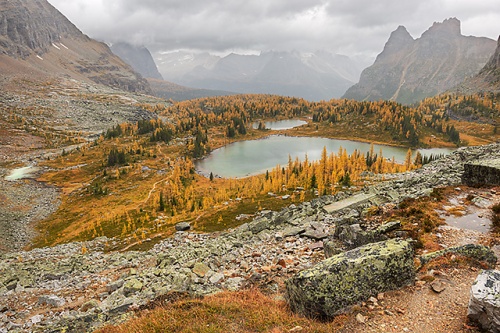
Hungabee and Cascade Lakes from the West Opabin Trail, Opabin Plateau, Yoho National Park, British Columbia
I can only imagine what the place would have looked like with anything approaching a clear vista, in any direction.
My discovery of an inlet stream to Hungabee Lake and the ensuing cascades and waterfalls was one of those “I have to get a shot” (or in this case, two) situations.
Lying at the northern end of the Opabin Plateau is a rocky outcropping called the Opabin Prospect. It overlooks the valley including Lake O’Hara and, even with the wind blowing rain in my face, I had to figure out some kind of way to get out to the edge and produce one image.
On my descent back to the valley, via the West Opabin Trail, I photographed the valley lakes from a slightly different perspective.
By the time I reached the valley floor–still about a mile short of the Le Relais shelter, which doubles as the Lake O’Hara bus depot, the rain had hardened. It was now mid-afternoon, and I had decided to take the next bus out (4:30 PM–I had a good, solid hour wait); I’d abandoned any plans to photograph around Lake O’Hara, given how cold and wet it was. It was a good call on my part, because not five minutes after I reached the shelter it started to really pour. For the next 90-odd minutes the rain alternated between hard and steady and outright downpour. The steady rain continued on the ride back to the parking area and all the way back to Lake Louise…and as far as I know, didn’t stop until some time well after dark.
I spent a good chunk of the evening using a hair dryer to dry out my backpack, hiking boots, and articles of clothing.
It had been an interesting day. The conditions (as I have undoubtedly demonstrated) were awful, but the place itself had been mind-blowing. I was left with the knowledge that I’d had my only crack at it. (I later found out that the next day–the only other day that it had been an option to secure a reservation–was a rerun in terms of all-day rain–which shocked me because I spent the day in and around Moraine Lake and Lake Louise and it didn’t rain at all.) I was left to ponder the means by which I could return to Lake O’Hara some day, in an attempt to give the place its photographic due through my eyes.
Next: Day 3 – Moraine Lake, Saddleback Pass and Takakkaw Falls
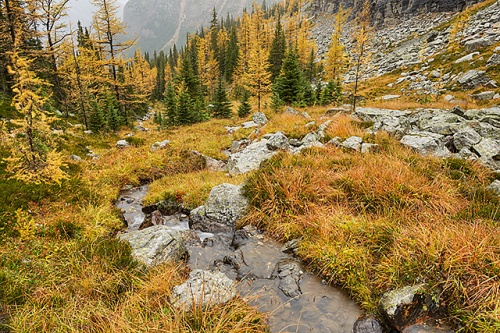
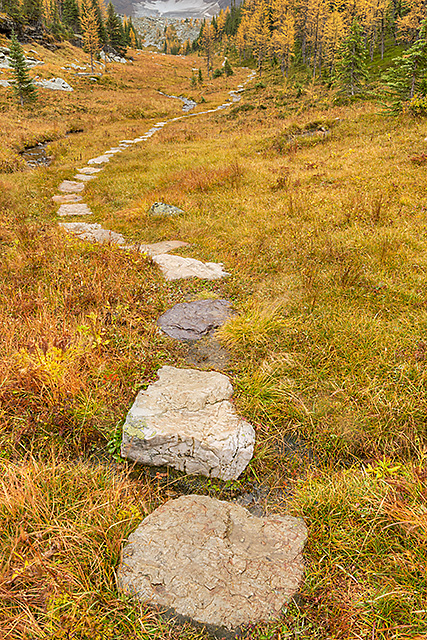
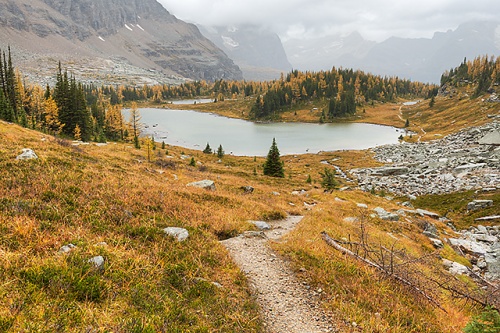
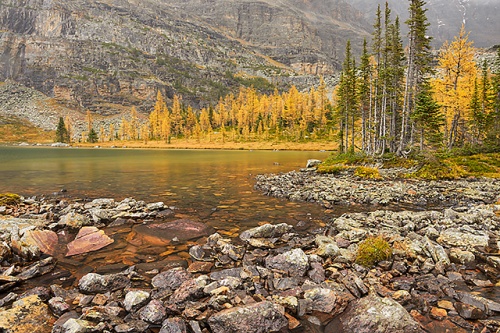

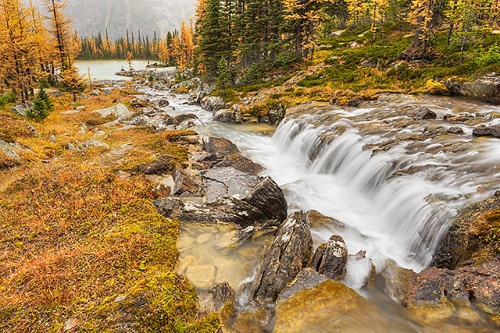
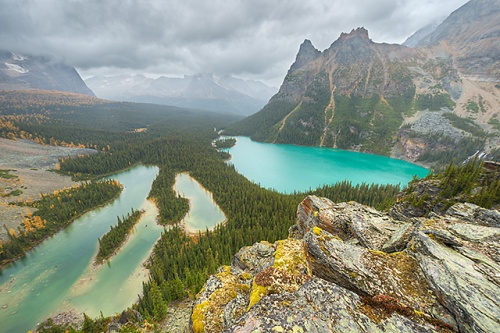



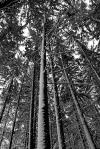



There are no words that can express how beautiful that area is, or how great your images are! And, even as good as your photos are, they still don’t really capture the totality of the awesomeness of the place, although yours come very close. I don’t mean that as a knock against your photos, the Canadian Rockies is an area that truly needs to be seen and experienced in person, for as great as the views are in any one direction, there are equally great views all around. I’ve been to most of the big named parks in the US, but all have paled compared to the Canadian Rockies, and that’s saying a lot. It is a shame that it rained the entire day that you were there, but that may have been for the best, otherwise, you may not have ever come back. 😉
By: quietsolopursuits on October 21, 2014
at 9:42 am
Agreed, the area really must be seen first hand to be truly appreciated, and I definitely think you’ve hit on one of the primary reasons why–the sense that you’re standing in the middle of it and incredible things can be seen no matter which direction you look. I think the Kootenay Plains area (which I’ll cover down the pike) probably epitomizes the 360-degree aspect of things as well or better than any other spot I visited during the trip, but it’s truly a ubiquitous concept in the region.
By: kerryl29 on October 21, 2014
at 1:55 pm
Isn’t Kerry just totally amazing Jerry? Wow, what an amazing day, and the determination it took for Kerry to trudge through the rain to get these spectacular images.
Truly the journey will never be forgotten and truly worth the effort. Makes me want to buy some underwater housing for my camera kit for days just as this.
Such an incredible series Kerry and thank you so much for sharing your story. It was well worth the effort.
By: Bella Remy Photography on October 22, 2014
at 6:49 pm
Thanks very much, Emily, for the exceptionally kind words.
BTW, don’t think I didn’t consider the advantage of having an underwater housing with me that day. 🙂
By: kerryl29 on October 22, 2014
at 9:58 pm
Lovely shots even in the rain. Not usually bothering with sophisticated post processing and often using super zooms and the like, especially on long hikes, I do like the fact the highlights and shadows are more controlled when the sun is not shinning bright.
By: centralohionature on October 21, 2014
at 9:46 am
Oh yes, I’ve extolled the oft-times considerable virtues of even light many times on this very blog. And I would have very comfortably settled for even light when I was at Lake O’Hara. (Some of the shots I’ve included certainly benefited from it, in fact.) The rain, on the other hand, I could have happily done without. 🙂
By: kerryl29 on October 21, 2014
at 1:57 pm
Your photos are gorgeous, in spite of the horrible weather. I give you a lot of credit for going out and shooting in the rain. I would have thrown in the towel.
By: Tuxedo Sophisticated Cat on October 21, 2014
at 9:53 am
Thanks.
My thinking about putting up with the rain can essentially be summed up with the following two notions:
1) the (unrealized) hope that it might actually stop, even for a few minutes at some point.
2) the recognition that there was no “trying again tomorrow”; I experienced this place then and there or I didn’t experience it at all.
The last image included in this post was the final shot of the day for me, after which time I’d pretty much checked out psychologically. The descent back to Lake O’Hara from the plateau, on the West Opabin Trail, wasn’t much fun; it’s an extremely steep trail at that point, which was rapidly turning to a combination of mud and wet rocks, and the rain was starting to come down harder. At that stage I just wanted to get down safely and get out of the wet.
By: kerryl29 on October 21, 2014
at 2:03 pm
We’ve had the conversation about how absolutely, unbelievably gorgeous Lake O’Hara is. Your photos demonstrate your determination to capture some of the beauty regardless of the conditions. I recognized Hungabee Lake even before I read the caption. You are meant to be here. I know you’ll be back.
By: EllenK on October 21, 2014
at 10:03 am
Thanks, Ellen. Truth is…I’m giving some very, very serious thought at this point about trying to get back next fall. I’m not yet sure if I’ll be able to do so, but if I do I’m thinking, at this preliminary stage, of something like 7-9 days and restricting myself to staying only in the Lake Louise area, which will give me pretty much full access to all of Yoho NP and that general area of Banff NP, plus the southern part of the Icefields Parkway, etc. I’m thinking about trying to reserve something like 3-5 separate days at Lake O’Hara, just to give myself a good chance of good weather up there. I figure it would take me two days to shoot out the plateau with good weather anyway, plus this would allow time to check out a few other trails, at least potentially. We’ll see…
By: kerryl29 on October 21, 2014
at 2:07 pm
Great work, Kerry, despite what you had to endure to get the work completed. We can only image what it would have looked like without the rain.
By: elmdriveimages on October 21, 2014
at 10:22 am
Thanks very much! I’m still trying to imagine how it would have looked in good weather myself. 🙂
By: kerryl29 on October 21, 2014
at 2:08 pm
These are wonderful photos, despite the conditions, Kerry. The story, on the other hand, is absolutely priceless.
By: Tom Robbins on October 21, 2014
at 10:41 am
Thanks very much, Tom!
By: kerryl29 on October 21, 2014
at 2:08 pm
Oh my! I truly feel your pain and frustration. This is at least the second time you’ve been skunked in some terrific photographic wonderland. That’s just gotta hurt. Hope the rest of the trip made up for it (at least to some extent!)
By: Gunta on October 21, 2014
at 10:57 am
The Lake O’Hara experience was, by leaps and bounds, the biggest disappointment of the trip. The second biggest was probably being unable to hike the Larch Valley Trail (which emanates from Moraine Lake) due to the group hiking restrictions in place at that time of the year (a function of bear activity), but I knew long before I left that this was the case. The thing about Lake O’Hara is that a reservation has to be set up so far in advance (three months) that there’s obviously no way to know what kind of weather you’ll get on the access day itself. And given how highly variable–and localized–weather conditions are there, it’s always going to be a crap shoot.
In any case, as unfortunate as this was, by no means did it ruin the rest of the trip–not even close, in fact. While there were a few other fizzle situations (e.g. sunrises or sunsets that didn’t really materialize), that’s utterly predictable over a two-week period, and for the most part conditions were pretty good the rest of the time.
By: kerryl29 on October 21, 2014
at 2:12 pm
Wonderful work. I love the high vantage points!
By: denisebushphoto on October 21, 2014
at 3:38 pm
Thank you!
By: kerryl29 on October 21, 2014
at 4:00 pm
Hey Kerry: I agree with your comments about photographers who say they “like” shooting in the rain. I can recommend a good psychologist 😁 .
Over the years, I have been very fortunate with weather, when I have committed a slot of time and $ for a trip somewhere I may not get back to easily. The one or two experiences where I have had rain have been situations where, like you did here, I have just had to make the best of a bad situation. I have made a couple images over the years where I have applied the old saying about lemonade from lemons.
You did that here. I am glad you hung in there long enough to make your penultimate image – I really like it. It is unique and I might even choose it over one in which the weather was much nicer.
As always – impressive work, reflecting you great preparation, determination and vision!
By: LightCentric on October 22, 2014
at 6:55 am
Thanks very much, Andy. I’ve been fairly lucky with conditions myself, for the most part. There have been exceptions, of course, and this Lake O’Hara experience was the most noteworthy and disappointing of them.
The image you singled out is worthy of a bit of background. I wanted to include all of Lake O’Hara (the lake to the right in the image) in the shot and I also wanted to include a bit of the rock face that forms the Opabin Prospect itself as part of the foreground for the purposes of depth, without having the rock merge with the background lake. That meant a bit of finagling with the tripod/camera position. The Opabin Prospect is a bit uneven, and there are some places where you have to step or jump over some good-sized gaps in the rocky floor to get where you want to go. In dry conditions, without the burden of a tripod and camera gear, these wouldn’t even merit a consideration, but with everything soaking wet and footing being less than ideal, I had to be pretty careful when maneuvering around. This was also the one time during the day that I changed lenses, from the 24-70 to the 14-24 (24 mm wasn’t wide enough). The rain (and wind) made this very difficult, but I managed to find a small overhang, about three feet above ground level, under which I placed my backpack and made the switch in the relative shelter of that position.
Just relating this story is a painful reminder of what a logistical PITA everything was that day. 🙂
By: kerryl29 on October 22, 2014
at 9:54 am
Ah Kerry, in spite of the difficult conditions, you captured magic through the lens. Thank you for sharing the great story as well as the spectacular images. The 4th photo has drawn me back over and over to look at it again.
By: composerinthegarden on October 25, 2014
at 11:18 pm
Thanks, Lynn.
The shot you referenced came as I hit a high spot, overlooking most of the northern 2/3 of the Opabin Plateau itself. It was raining (of course), and the wind started blowing while I was trying to size up the shot, and it was swirling, which was a real pain in the behind. The worst part was that I could see that I needed a polarizer on the lens to kill the glare coming off the water surfaces you see in the frame. Just attaching that filter, under the conditions, was a royal pain in the behind. I draped a plastic bag I had with me for just this sort of contingency over the entire tripod-mounted rig and screwed the filter on the front element of my 24-70 mm lens. This wasn’t easy because, in addition to the obvious problems of working with the inside of the bag, the wind was blowing it all over the place, making things even more difficult. Then there was the problem of properly rotating the filter without getting it splotched with rain drops…ugh, this retelling of the story is bringing the whole thing back to me in glorious technicolor. 🙂 Geez, that whole experience was frustrating.
By: kerryl29 on October 26, 2014
at 1:05 pm
The amazing thing, Kerry, is that you persevered and got such gorgeous shots, in spite of horrible conditions. I must admit I am a fair weather photographer and gardener; I think I’m just getting too old to deal with those conditions. So, kudos to you for hanging in there and taking away something so extraordinary!
By: composerinthegarden on October 26, 2014
at 1:11 pm
Thanks again, Lynn, for the kind words. I really appreciate it.
In spite of myself, I’m not satisfied with the Lake O’Hara area shots, at least in part, because I had a chance to get a sense of the real potential of the place, and how far short of that potential I fell. The dissonance on my part is so acute that I’m seriously attempting to see if I can manage to get back there next fall and rectify the shortcomings.
I haven’t felt an urge this strong to return to a location at least since my first visit to the Canaan Valley area of West Virginia in October, 2010. The conditions during my few days there were so bad (lousy color, high winds and blue sky days) that I came back with very little that was worthwhile despite the incredibly obvious potential. I went back for a full week the following autumn and scratched that itch, quite successfully, I think. This experience isn’t entirely analogous since I most certainly didn’t strike out for the entire time in the Rockies–quite the contrary, in fact (I came back with so much that even now, three weeks after returning, I still haven’t worked up at least 60% of my shots). My disappointment is almost entirely limited to Lake O’Hara itself, but I can’t seem to help myself in terms of the desire to get back there. We’ll see what happens.
By: kerryl29 on October 26, 2014
at 1:49 pm
I empathise with your weather experience, as it has happened to me but it does show how beautiful it is even in adverse conditions.I love the golden glow in the fifth photo of Hungabee Lake and the vista in the second-last one.
By: My Heartsong on October 27, 2014
at 12:34 am
Thanks, Jane. Glad you noticed that glow in the one Hungabee Lake image–it was the only time all day (this would have been early in the afternoon) something like that happened. This was at a point where I actually thought the rain might stop–it was very light at that stage and things brightened considerably very briefly. I never actually saw any sunlight, but there must have been a significant thinning of the cloud layers. It lasted for a minute, perhaps. Then it got darker and the rain picked up again and it never really slackened for the remainder of the day.
By: kerryl29 on October 27, 2014
at 9:01 am
[…] the aftermath of a disappointing day at Lake O’Hara, I had hopes for better luck on Day 3. My plan was to shoot sunrise at Moraine Lake, about a […]
By: The Canadian Rockies, Day 3: Moraine Lake, Saddleback Pass & Takakkaw Falls | Lightscapes Nature Photography Blog on October 28, 2014
at 8:54 am
[…] of this post, you’ve seen plenty of them in the earlier installments of the series (Day 1; Day 2; Day 3; Day 4) and you’ll surely see many, many more if you continue to follow along as I […]
By: Thematic Interruption: The Elements of Style | Lightscapes Nature Photography Blog on November 12, 2014
at 9:46 am
[…] place to place. The weather wasn’t always cooperative, but it never is (I direct you to my Lake O’Hara experience), and I was impressed at just how well time was apportioned at each location. I was every bit as […]
By: The Canadian Rockies: Thematic Interruption – The Tour Experience | Lightscapes Nature Photography Blog on December 10, 2014
at 11:12 am
[…] Rockies as any scenic genre it was my pleasure to witness, be it the Hillsdale Meadows, the Opabin Plateau, the Bow River Outlet Trail, the Palisades Picnic Area or the unnamed meadow that I’d spent […]
By: The Canadian Rockies: Day 8 – Athabasca Falls, Icefields Parkway Southbound, Sunwapta Falls and an Introduction to the Kootenay Plains | Lightscapes Nature Photography Blog on December 16, 2014
at 9:11 am
[…] advantages of my two-camera setup multiple times every day while in Canada with the exception of my day at Lake O’Hara, and that was only because the weather was so awful that day that I scarcely pulled out one camera, […]
By: Thematic Interruption: Two Cameras | Lightscapes Nature Photography Blog on December 30, 2014
at 9:01 am
[…] larches I’d seen since my time at Banff National Park, most notably at Saddleback Pass and a day earlier on the Opabin Plateau at Yoho National Park. This was a very different setting for larch than the high elevation subjects I’d seen […]
By: The Canadian Rockies Day 10 – Sunrise Mountain Views, Larch in Snow, Nordegg and Whirlpool Point | Lightscapes Nature Photography Blog on January 5, 2015
at 8:01 am
[…] good as far as color was concerned; I received good weather (mostly–we won’t talk about Lake O’Hara); I had excellent sources upon which to draw and covered a lot of ground without feeling too […]
By: The Canadian Rockies: A Retrospective | Lightscapes Nature Photography Blog on February 16, 2015
at 9:00 am
[…] on a couple of disappointments–most particularly a day of miserable weather at the elusive Lake O’Hara. As a result, I came home with a burning desire to return to the region as soon as possible. […]
By: The Canadian Rockies Revisited | Lightscapes Nature Photography Blog on October 5, 2015
at 9:55 am
[…] on this trip to revisit the place that had vexed me so heavily the previous year–the Lake O’Hara area. Last year’s highly anticipated visit had been negatively impacted by all-day rain. […]
By: The Canadian Rockies Day 5: | Lightscapes Nature Photography Blog on November 23, 2015
at 8:24 am
[…] Truth be told, by far the single most consequential reason for my return to the Canadian Rockies in the fall of 2015 was my experience at Lake O’Hara the previous year. (For a full account of that debacle, go here.) […]
By: Canadian Rockies Day 6: Scratching the Itch, Part I | Lightscapes Nature Photography Blog on December 1, 2015
at 9:22 am
[…] And so I did. At this stage, I abandoned any thoughts of photographing at Lake Oesa; I simply hoped to get a little bit of time back at Lake O’Hara before I’d have to take the 6:30 bus back to the parking lot. The rest of the time, it was clear, was going to be spent photographing on the Opabin Plateau. I could tell that I wasn’t going to be able to pass up the countless photographic opportunities that lay ahead. I was now on the back end of the Opabin Circuit, arguably the most visually varied and compelling section of what is, perhaps, the most beautiful place I’ve ever seen in my life. To make matters even more compelling, the area was in its finest dress: peak larch color, snow coating all of the surrounding peaks and ridges, beautiful skies and glass-like water surfaces in all of the small lakes and ponds. In short, here I was, experiencing what I’d scarcely ventured to dream this place might be like when I was trudging through the constant rain–a circumstance more the rule than the exception at this place, I’d come to learn–on my single visit the previous autumn. […]
By: Canadian Rockies Day 7: Scratching the Itch, Part II | Lightscapes Nature Photography Blog on December 15, 2015
at 9:44 am
[…] was to rectify the disaster that was my one-day experience at Lake O’Hara. If you read my account of that day in the rain, you’ll get a sense of my frustration: I could see the incredible beauty of the […]
By: Canadian Rockies Thematic Interruption: Lake O’Hara – A Retrospective | Lightscapes Nature Photography Blog on December 29, 2015
at 9:26 am
[…] when it was time to board the 10:30 bus, I’d pass. (I had no interest in reliving the previous year’s experience.) If not, I’d […]
By: Canadian Rockies Day 10: Down Time | Lightscapes Nature Photography Blog on January 26, 2016
at 9:13 am
[…] was, of course, my inability to properly photograph the larch-strewn Opabin Plateau above Lake O’Hara in Yoho National Park in 2014 that had me […]
By: Thematic Interruption: That Time of the Year Is Just Around the Corner | Lightscapes Nature Photography Blog on August 8, 2016
at 8:44 am
[…] https://lightscapesphotography.wordpress.com/2014/10/21/the-canadian-rockies-day-two-lake-ohara/ […]
By: A Bridge | Lightscapes Nature Photography Blog on October 14, 2016
at 8:12 am
[…] https://lightscapesphotography.wordpress.com/2014/10/21/the-canadian-rockies-day-two-lake-ohara/ […]
By: Favorite Trails for Photography, Part I | Lightscapes Nature Photography Blog on July 30, 2018
at 8:44 am
[…] (Access to the area is restricted; you can read more about the details here.) As I noted in my post covering the experience, after great anticipation, I was “treated” to absolutely […]
By: Second Chances | Lightscapes Nature Photography Blog on February 11, 2019
at 8:41 am
[…] to steady, all day long. We tried to make the best of it, but the experience reminded me of my very first visit to Lake O’Hara, in the Canadian Rockies: when you have almost no shelter, it’s chilly and you’re out […]
By: Alaska Revisited, Day 13: The Day that Wasn’t | Lightscapes Nature Photography Blog on June 6, 2022
at 8:02 am
[…] and is a worthy photo destination in its own right–many times previously on this blog. My first trip to the area was among the most frustrating experiences I’ve ever had on a photo trip, due to […]
By: The Story Behind the Image: Opabin Plateau | Lightscapes Nature Photography Blog on January 23, 2023
at 8:00 am